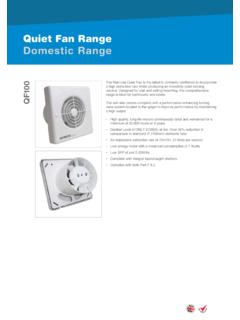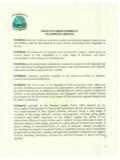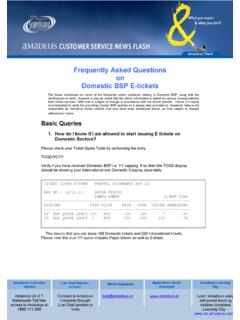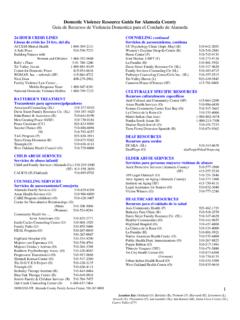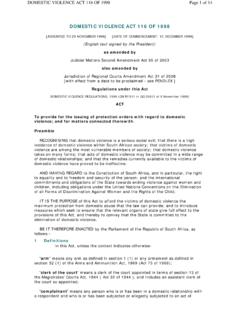Transcription of Review of Domestic Gas Safety - Report for the …
1 HE0502-79 Review of Domestic Gas Safety Report for the Health and Safety Executive 9 Staple Inn Holborn London WC1V 7QH Tel 0207 404 7005 Fax 0207 404 8010 HE0502-79 Review of Domestic Gas Safety Final Report for the Health and Safety Executive Contents Page Executive Summary 1. Methodology and Process 1 2. Domestic Gas Safety 4 3. Reducing the Risk of CO Poisoning 10 4. Gas Installer Competence 16 5. Illegal Installers 22 6. Legislative Framework and Standards 26 7. Framework Options 29 8. Concluding Remarks 37 Executive Summary 1. The purpose of this Review is t o explore the current arrangements to promot e Domestic gas Safety across the UK, to identify areas of str ength and weakness, and to make recommendations for the future. This is a surprisingly complex subject, involving a number o f disparate stakeholders and some significant te nsions both within the industry and from external interests, including pressure groups.
2 This Report has been produced after an extensi ve period of stakeholder consultation and involvement, commencing in February 2006 and including 2 stakeholder conferences, a questionnaire, over 50 interviews with organisations and individuals, and a ser ies of workin g groups. It covers piped gas an d LPG use d in domest ic homes in the UK. We would like to thank all those who have given s o much of their time and were so helpful. 2. The responsibility for administration of the existing regulations rests with HSE, which delegates certain functions to a registration body known as CORGI. Any g as installation business undertaking commercial installation or maintenance of a gas appliance in UK Domestic premises must be registered wit h CORGI. There are a number of requirements for registra tion, including for every emplo yed gas fitting operative an asse ssment of competency every 5 years (the ACS scheme), a portfolio of experience and, normally, a qualific ation.
3 CORGI inspects the work of registered installers at intervals. HSE is e mpowered to enforce the relevant legislation and may issue a written warning in response to a complaint or institute formal legal proceedings with respect to a more serious incident. 3. This has been widely regarded as a safe industry, and reported fatalities have reduced to less than 30 per annum. Most deaths are caused not by fire or explosion, but by CO poisoning: CO is a co lourless, odourless gas given off by burning a combustible fuel, such as gas or oil, in the absence of adequate ventilation. Exposure to CO can cause death, permanent serious disability, or, at lower levels, more temporary, flu-like symptoms. As well as affecting quality of life, undiagnosed CO poisoning may pre vent individuals enterin g employment, be a charge on the NHS, on sick pay and other support schemes.
4 4. There is, however, some indication that the incidence of CO poisoning and even the level of fatalities may be under-reported. Research also suggests that there may be a number of homes with potentially dangerous levels of background C O linked to patterns of use and faulty, or poorly ventilated, gas appliances, representing an unquantified health risk. Recent studies further suggest that the public may have a poor awareness of the concept, dangers and causes of CO poisoning. Industry e fforts to raise awareness are limited and not well co-ordinated. There is a real risk that, in the light of emerging evidence about the potential pre valence of CO, the i ndustry may be judge d irresponsible if action is not now ta ken to address this issue. This could have a far more damaging commercial effect than measured communication th at alerts th e public, including health professionals, to the dangers of CO and how to manage these.
5 5. Risk patterns are changing with regard to CO poisoning: households most at risk appear increasingly to be those where current laws do no t identify a duty holder to ensure safe installation and regular checking of gas appliances, eg: owner-occupied premises rather than multiple o ccupancy rented accommodation. It seems unlikely that legislation and the associated enforcement will be introduced to cover this area: increased awareness of the potential CO hazard therefore appears the only option if the risk is to be reduced. 6. It is essential that steps are taken to increase public awareness of the CO hazard, given the pote ntial to cause death and serious injury, changing patterns of risk and recent evidence suggesting that the public hea lth risk may be more widespread than previously acknowledged. In order to deliver this, there will need to be: additional funds a co-ordinating body involvement from a wider range of interests, including Health We therefore recommend that an i ndustry co-coordinating body be set up to initiate work and fund raising in support of CO awareness.
6 This should be chaired by a respected and high profile public figure, and should involve a variety of interest groups and government departments, including DWP, DCLG and DH. The Domestic gas registration body/bodies may play a significant an d increasing role in the management and support of this group, and should be encouraged so to do. Indeed, there is logic in this co- coordinating function being assigne d to the ga s registration body/bodies and we so recommend. The CO awareness co-ordinating body sho uld explore cases for a variety of initiatives, some focused, others more wide ra nging, and should act t o co-ordinate existing efforts and take advantage of untapped but inexpensive opportunities, eg : leaflets which cou ld be sent with gas b ills, left by installers and the emergency services. Funds may come from a variety of sources including industry contributions, existing surplus from registration fees, rise in registration and ACS incomes f rom additional registration, CORGI Trust (which receives the profits fr om CORGI s commercial activities).
7 If these funding streams are in sufficient, legislation may be needed t o produce a levy on the industry: if th is is required, other fuels which can produce CO in situations of incomplete combustion should also be included. Other initiatives considered by the CO awareness co-ordinating body should include: audible CO detection alarms, which can be very effective and reliable what more can realistically be done by the emergency gas services when attending at a possible CO poisoning situation phasing out of old and open flued appliances, especially boilers, which represent higher risk use of the home energy rating scheme to high light hazards and Safety measures connected with Domestic gas promotion of clinical awareness of CO sympto ms and detectio n, especially among GPs and pathologists Increased public CO a wareness will al so reduce some of the tension s within the industry.
8 For example, if householders are aware of the dangers, t hey are mo re likely to use a registe red gas pr ofessional, thus reducing the level of illegal, unregistered installers and consequent pressure from legal insta llers for greater investment in enforcement. This will also dri ve more current illegal installers t o register, increasing the flow of revenue to ACS providers and the registration body: this could be used to reduce costs t o installers and/or to part-fund a CO awareness campaign. 7. The current ACS scheme and registration systems are widely seen by installers a s being too onerous and inflexible and may well discourage registration. A strong , independent voice is required to challenge the assessment system and standards for ACS certification. Step s within the industry to address this should be encouraged and accelerated.
9 The aim should be to produce an approach that is: risk based simplified allows individuals to demonstrate competence with a more flexible mix of assessment, inspection, qualifications, experience and continuous professional development The registration body/bodies must ensure that registration criteria also reflect this changed approach. 8. There are some concerns abo ut the competence of registered installers, particularly following recent introduction of more random inspections by CORGI. This needs further attention and we would suggest: that the ACS scheme aims to improve overall standards of competence by engendering more generic skills that CORGI Review the action taken if a substandard installation is found, eg: compulsory additional training, higher levels of insp ection and an increased registration fee while supporting the concept of the gas works notification scheme, wh ich allows more random in spections, the methodo logy should be reviewe d, eg: allow the installer to certify his work direct with the customer and send a copy of the paperwork to CORGI, rather than the other way around use of flue gas analysers should be mandatory when installing or servicing open flued appliances 9.
10 A number of issues o f some substance have been ident ified with re spect to th e interface between HSE and the registration body, and its management and role. We recommend that HSE Review these issues and invite expressions of interest from appropriately qualified organisations wishing to take on th e role of th e registration body. An assessment of competency should be made b y an HSE pa nel against a number of criteria, including: delivery of key issues outlined in this Report , especially co-ordinating action to promote CO awareness and changes to competency and registration systems a business case to d emonstrate how the registration scheme will be funded without additional cost to installers an improvement in key Safety issues ability to work with stakeholders and other registration bodies innovative approaches and added value probity and transparency in governance, especially with regard to conflict of interest, commercial enterprise, interface with HSE delivery of key aspects of the registration sche me, eg geographic cover, installer and public help lines, managing complaints a consumer voice Organisations satisfying the panel would be recognised as registration bodies for a reasonable period.










